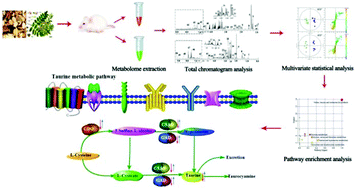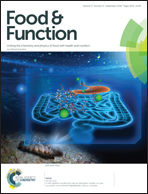The intervention effect of licorice in d-galactose induced aging rats by regulating the taurine metabolic pathway†
Abstract
Licorice, an edible and officinal plant material, has attracted considerable attention for its wide range of pharmacological activities. Our previous study showed that licorice can ameliorate cognitive damage and improve oxidative stress and apoptosis in aging rats induced by D-galactose (D-gal). In this study, in order to further explore the changes of the metabolic profile during the aging process and the antiaging mechanism of licorice, the 1H NMR-based metabolomics approach was used to analyze serum and urine samples and identify a potential biomarker in D-gal induced aging rats. The results revealed that the taurine metabolic pathway was significantly correlated with the ageing process in D-gal induced rats. Furthermore, the taurine contents were significantly decreased in both the serum and urine samples of aging rats compared with the controls. At the same time, the levels of cysteine dioxygenase type I (CDO1), cysteine sulfinic acid decarboxylase (CSAD) and glutamate decarboxylase type I (GAD1), which are the key enzymes affecting the synthesis reactions, were decreased in aging rats compared with the controls. After licorice administration, the levels of taurine, CDO1 and CSAD were all significantly increased. These findings firstly demonstrated that the regulation of the taurine metabolic pathway is involved in the anti-aging effect of licorice in D-gal induced aging rats.



 Please wait while we load your content...
Please wait while we load your content...